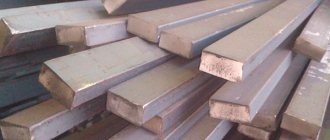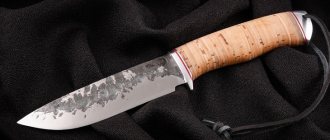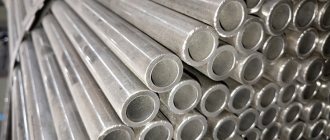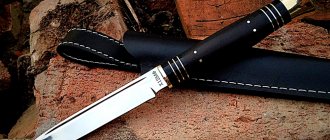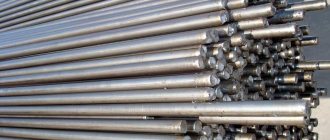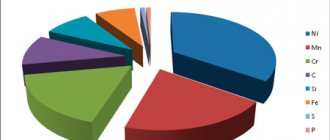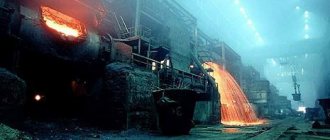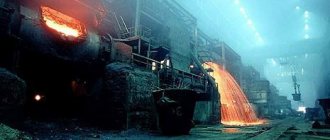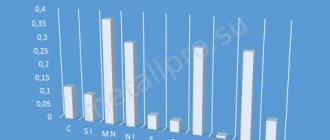- Strenx high-strength steels: description
- Strenx 600 steel: chemical composition and mechanical properties
- Strenx 650 steel: chemical composition and mechanical properties
- Steel group Strenx 700: chemical composition and mechanical properties
- Steel group Strenx 900: chemical composition and mechanical properties
- Steel group Strenx 1100: chemical composition and mechanical properties
- Steel group Strenx 1300: chemical composition and mechanical properties
- Characteristics and Applications of Strenx High Strength Steels
Strenx high-strength steels: description
High-strength steel Strenx* (until 2015 - Weldox steel)
is a structural steel with guaranteed accuracy of thickness and flatness over the entire area of the rolled sheet. This brand was developed by the Swiss company SSAB for the production of components for heavy machines and tools, the strength and wear resistance of which are subject to increased demands. In addition, SSAB specialists were faced with the task of obtaining high-strength steel along with reducing its weight: using Strenx brand metal products for the production of metal products, their weight can be reduced by up to 40%.
The main advantage of Strenx brands is the tensile strength reaching a phenomenal 1100 MPa due to a special alloying concept and the reduction of harmful impurities in the chemical composition. Steel is produced in sheets, strips, and rolls.
Strenx steel is regulated by several basic standards*:
- EN 10025-6 / EN 10149-2 – chemical composition, mechanical properties and control tests;
- EN 10029 / EN 10051 – technical tolerances for shape, thickness, flatness;
- EN 10163-2 class A subclass 3 – technical tolerances for surface quality.
*
Additional industry standards may be specified for each group of steel grades.
Low-carbon steels of ordinary quality
From the group of low-carbon steels of ordinary quality produced by the metallurgical industry in accordance with GOST 380 - 88, steel grade St3 is widely used in construction.
Steel grade St3 is produced boiling (ST3kp), semi-quiet (St3ps) and calm (St3sp).
Depending on the purpose, steel is supplied in the following three groups, which indicate the properties by which steel is standardized:
A - by mechanical properties;
B - by chemical composition;
B - according to mechanical properties and chemical composition
Since it is necessary to ensure strength and weldability for load-bearing building structures, as well as adequate resistance to brittle fracture and dynamic impacts, steel for these structures is ordered according to group B, i.e., with a guarantee of mechanical properties and chemical composition.
Steel grade St3 contains 0.14 – 0.22% carbon.
According to GOST 380 - 88, steel marking is done as follows: first put the corresponding letter designation of the steel group, then the grade, then the deoxidation method and finally the category; for example, steel of group B (supplied according to mechanical properties and chemical composition) grade St3 is semi-quiet, category 5 is designated VSt3ps5.
The category indicates which mechanical properties of steel are preserved at temperatures of -20 and +20 degrees Celsius. Ordinary quality steels are divided into 5 categories. The table of standardized indicators by category is given in GOST 535-88.
Strenx 600 steel: chemical composition and mechanical properties
Brand Strenx 600MC
is a hot-rolled structural steel intended for cold stamping. Recommended for the production of light metal structures.
Deliveries are made in coils, rolls, sheets of the following sizes:
- thickness – from 2 to 10 mm;
- width – up to 1600 mm;
- length – up to 16 m when supplied in sheets.
Chemical composition of Strenx 600MC
| C | Si | Mn | P | S | Al | Nb | V | Ti |
| 0,12 | 0,21 | 1,90 | 0,025 | 0,010 | 0,015 | 0,09 | 0,20 | 0,15 |
Mechanical properties
| Thickness, mm | Min. yield strength, MPa | Min. tensile strength, MPa | Relative elongation1,% | Relative elongation2,% | Minimum internal bend radius (90°) |
| 2-3 | 600 | 650-820 | 13 | 16 | 0.7*t |
| 3,01-6 | 600 | 650-820 | 16 | 1.1*t | |
| 6,01-10 | 600 | 650-820 | 16 | 1.4*t |
- 1 – for thickness <3.00 mm;
- 2 – for thickness ≥3.00 mm.
Impact properties*
| Brand | Minimum impact energy for longitudinal samples (Charpy V test on a 10x10 mm sample) |
| Strenx 600MC D | 40 J/ -20°C |
| Strenx 600MC E | 27 J/ -40°C |
*
Impact tests are carried out in accordance with EN ISO 148-1 on samples with a thickness of 6 mm.
Strenx 650 steel: chemical composition and mechanical properties
Strenx 650MC grade is hot-rolled structural steel with a yield strength of 650 MPa. Recommended for load-bearing metal structures, in the manufacture of which an overall reduction in weight with consistently high strength values is important.
Deliveries are made in rolls and sheets of the following sizes:
- thickness – from 2 to 10 mm;
- width – up to 1600 mm;
- length – up to 16 m.
Chemical composition of Strenx 650MC
| C | Si | Mn | P | S | Al | Nb | V | Ti |
| 0,12 | 0,21 | 2,00 | 0,025 | 0,010 | 0,015 | 0,09 | 0,20 | 0,15 |
Mechanical properties
| Thickness, mm | Min. yield strength, MPa | Min. tensile strength, MPa | Relative elongation1,% | Relative elongation2,% | Minimum internal bend radius (90°) |
| 2-3 | 650 | 700-850 | 12 | 14 | 0.8*t |
| 3,01-6 | 650 | 700-850 | 14 | 1.2*t | |
| 6,01-10 | 650 | 700-850 | 14 | 1.5*t |
- 1 – for thickness <3.00 mm;
- 2 – for thickness ≥3.00 mm.
Impact properties*
| Brand | Minimum impact energy for longitudinal samples (Charpy V test on a 10x10 mm sample) |
| Strenx 650MC D | 40 J/ -20°C |
| Strenx 650MC E | 27 J/ -40°C |
*
Impact tests are carried out in accordance with EN ISO 148-1 on samples with a thickness of 6 mm.
Welding technology for joining high-strength steels
When welding medium-alloy, deeply hardening, high-strength steels, it is necessary to select welding materials that will ensure the production of welds with high deformation capacity with a minimum amount of hydrogen in the weld pool. This is achieved by using low-alloy welding electrodes, which do not contain organic substances in the coating and are subjected to high-temperature calcination (low-hydrogen electrodes). In this case, it is necessary to exclude other sources of saturation of the weld pool with hydrogen during welding (rust, moisture, etc.). High technological strength is obtained with the following content of alloying elements in the weld metal: C – no more than 0.15%; Si – no more than 0.5%; Ni – no more than 2.5%; Mn – no more than 1.5%; Cr – no more than 1.5%; V – no more than 0.5%; Mo – no more than 1.0%.
Increasing the weld properties to the required level is possible by alloying the weld metal at the expense of the base metal. The required strength characteristics of the weld metal are achieved by alloying it with elements that increase strength, but do not reduce its impact strength and deformability. To weld medium-carbon high-strength steels, you need to choose welding materials that contain less alloying elements than the base metal.
Manual arc welding with coated electrodes
For welding medium-alloyed high-strength steels, electrodes of types E-13Х25Н18, E-08Х21Н10Г6 and others are used in accordance with GOST 10052-75 and GOST 9467-75. If the steel before welding was subjected to heat treatment for high strength (quenching and tempering or normalization), and after welding - tempering to relieve stress and equalize the mechanical properties of the welded joint, then the criterion for determining the preheating temperature will be the cooling rate at which partial hardening would occur near-heat zone. This ensures that there are no cracks during the welding process and before further heat treatment.
To improve the weldability of hardened metals, special electrodes are required
In the case when heat treatment of a welded product cannot be done, for example, due to its large dimensions, a non-hardening layer of metal is deposited onto the edges of the part to be welded with austenitic or low-carbon electrodes. The thickness of this layer should be such that the temperature of the steel under the layer during the welding process does not exceed the tempering temperature during heat treatment of parts with deposited edges. Such parts are welded with austenitic or low-carbon and low-hydrogen electrodes without heating and further heat treatment. The welding mode is taken according to the recommendations for austenitic electrodes.
Welding work in shielding gases
High quality of welded joints made of medium-carbon high-strength steels with a thickness of 3...5 mm is achieved by argon arc welding with a non-consumable electrode. The filler material for gas shielded arc welding should be selected depending on the gas in which the welding takes place. The first layer is performed without an additive with full penetration of the joint edges, the second - with transverse low-frequency vibrations of the electrode and mechanical feed of the filler wire. It is also possible to perform the third layer with transverse vibrations of the electrode without filler wire at a low mode to ensure a gradual transition from the weld to the base metal.
To increase the penetration ability of the arc during argon-arc welding, activating fluxes are used, which make it possible to eliminate the cutting of edges with thicknesses of 8...10 mm. Flux is also used, which is a mixture of components (TiO2, SiO2, NaF, Cr2O3). This method with activating flux is effective with mechanized methods to obtain a uniform penetration depth. The non-consumable electrode for this welding method is selected from the most resistant grades of tungsten.
Modern argon burner
When welding medium-alloyed high-strength steels in shielding gases (mainly inert or their mixtures with active ones), low-carbon alloyed and austenitic high-alloy wires are used, for example, Sv-08Kh20N9G7TT, Sv-03KhGN3MD, Sv-10KhGSN2MT, Sv-10Kh16N25-AM6, Sv-08Kh21N10G6 . However, it is not possible to obtain equal strength of the weld metal and the steel being welded. In this case, it is possible to ensure equal strength due to the effect of contact strengthening of the soft weld metal. This effect can be realized using the so-called slot groove, which is butt joints with a narrow gap.
Submerged arc welding
Structural elements of edge preparation for automatic and semi-automatic submerged arc welding are performed in accordance with GOST 8713-79. However, in the range of thicknesses for which welding without groove and with beveled edges is possible, the latter should be preferred. When mechanized submerged arc welding, edge preparation, technique and welding modes are required in which the proportion of base metal in the weld would be minimal. But this technique increases the likelihood of hot cracks forming in the welds.
The choice of flux depends on the brand of electrode wire. When using low-carbon wire, welding is performed under acidic high- and medium-manganese fluxes. When using low-alloy wires, the best results are achieved by using low-silicon and low-manganese fluxes. Welding of medium-alloyed high-strength steels with austenitic wire of the Sv-08Kh21N10G6 or Sv-08Kh20N9G7T grades is carried out only using non-oxidizing or weakly oxidizing basic fluxes.
Electroslag welding
Scheme of the welding process
This type of welding work can be rationally used for joining thick-sheet structures made of medium-alloy high-strength steels. The main types and structural elements of welded joints and seams must comply with the requirements of GOST 15164-78. When welding with a consumable tip and wire electrodes, electrode wires are selected from among the groups of alloyed or high-alloy wires in accordance with GOST 2246-70. To prevent cracks in the heat-affected zone when welding rigidly fixed elements, it is necessary to use preheating to 150...200°C.
The low cooling rate of the heat-affected zone during electroslag welding leads to a long stay in the zone of high temperatures, causing grain growth and embrittlement of the metal. In this regard, after electroslag welding of medium-alloy high-strength steels, it is necessary to perform high-temperature heat treatment of welded products to restore mechanical properties to the required level. The time from the end of welding to the heat treatment must be regulated.
Steel group Strenx 700: chemical composition and mechanical properties
Steel Strenx 700MC
- this is a group of high-strength steels with a minimum yield strength of 650-700 MPa, depending on the thickness of the flat products. Designed for the production of cold-formed and welded metal products, for which there are increased requirements for low weight with high strength, increased payload and load-bearing capacity. Supplied in sheets, rolls, strips.
Standard sheet sizes:
- thickness of hot-rolled sheet – from 2 to 120 mm;
- thickness of cold-rolled sheet – from 0.7 to 2.1 mm;
- width – up to 3350 mm;
- length – up to 16 m.
Chemical composition of Strenx 700MC
| C | Si | Mn | P | S | Al | Nb | V | Ti |
| 0,12 | 0,21 | 2,10 | 0,020 | 0,010 | 0,015 | 0,09 | 0,20 | 0,15 |
Mechanical properties
| Thickness, mm | Min. yield strength, MPa | Min. tensile strength, MPa | Relative extension, % | Minimum internal bend radius (90°) |
| 2-3 | 700 | 750-950 | 10 | 0.8*t |
| 3,01-6 | 700 | 750-950 | 12 | 1.2*t |
| 6,01-10 | 700 | 750-950 | 12 | 1.6*t |
Impact properties*
| Brand | Minimum impact energy for longitudinal samples (Charpy V test on a 10x10 mm sample) |
| Strenx 700MC D | 40 J/ -20°C |
| Strenx 700MC E | 27 J/ -40°C |
*
Impact tests are carried out in accordance with EN ISO 148-1 on samples with a thickness of 6 mm.
Brand Strenx 700 E/F
– high-strength steel, which is designed specifically for complex load-bearing structures operating, including at temperatures up to – 60°C.
Standard sheet sizes:
- sheet thickness 700 E – from 4 to 160 mm;
- sheet thickness 700 F – from 4 to 130 mm;
- width – up to 3350 mm;
- length – up to 14630 mm.
Chemical composition of Strenx 700 E/F
| C | Si | Mn | P | S | Cr | Cu | Ni | Mo | B |
| 0,20 | 0,60 | 1,60 | 0,020 | 0,010 | 0,80 | 0,30 | 2,0 | 0,70 | 0,005 |
Mechanical properties
| Thickness, mm | Min. yield strength, MPa | Min. tensile strength, MPa | Relative extension, % |
| 4,0-53,0 | 700 | 780-930 | 14 |
| 53,1-100,0 | 650 | 780-930 | 14 |
| 100,1-160 | 650 | 710-900 | 14 |
Impact properties
| Brand | Minimum impact energy for transverse samples (Charpy V test on a 10x10 mm sample) |
| Strenx 700 E | 69 J/ -40°C |
| Strenx 700F | 27 J/ -60°C |
Brand Strenx 700MC Plus
is a fine-grained structural steel with increased cold ductility and high impact strength for operation in difficult operating and climatic conditions at low temperatures. Characterized by plasticity and pliability to cutting.
Standard sheet sizes:
- thickness – from 3 to 12 mm;
- width – up to 1525 mm;
- length – up to 12300 mm.
Chemical composition of Strenx 700MC Plus
| WITH | Si | Mn | P | S | Al | Nb | V | Ti |
| 0,12 | 0,25 | 2,10 | 0,020 | 0,010 | 0,015 | 0,09 | 0,20 | 0,15 |
Mechanical properties
| Thickness, mm | Min. yield strength, MPa | Min. tensile strength, MPa | Relative extension, % | Minimum internal bend radius (90°) |
| 3-10 | 700 | 750-950 | 13 | 1.0*t |
| 10,01-12 | 700 | 750-950 | 13 | 1.5*t |
Impact properties*
| Minimum impact energy for longitudinal samples (Charpy V test on a 10x10 mm sample) | 40 J/ -60°C |
*
Impact tests are carried out in accordance with EN ISO 148-1 on samples with a thickness of 5 mm. At the customer's request, it is possible to conduct tests on transverse samples.
Brand Strenx 700CR
is a fine-grained cold-rolled structural steel with a minimum yield strength of 700 MPa.
Standard sizes of cold rolled sheets:
- thickness – from 0.7 to 2.1 mm;
- width – up to 1500 mm;
- length – up to 8500 mm.
Chemical composition of Strenx 700CR
| WITH | Si | Mn | P | S | Al | Nb+Ti |
| 0,16 | 0,40 | 1,80 | 0,020 | 0,010 | 0,015 | 0,10 |
Mechanical properties
| Thickness, mm | Min. yield strength, MPa | Min. tensile strength, MPa | Relative extension, % | Minimum internal bend radius (90°) |
| 0,70-2,10 | 700 | 1000-1200 | 7 | 2.0*t |
Brand Strenx 700 OME
– this is cold-rolled structural steel with a minimum yield strength of 700 MPa and a service temperature of up to – 60°C. Designed specifically for heavy load-bearing metal structures in the marine and shipbuilding industry.
This brand has been certified:
- sheets from 4.8 to 130 mm - American Bureau of Shipping AB EQ70;
- sheets from 6 to 80 mm - Norwegian classification society DNV GL;
- sheets from 8 to 80 mm - British shipping classification society Lloyds Register LR.
Standard sizes of cold rolled sheets:
- thickness – from 4 to 130 mm;
- width – up to 3350 mm;
- length – up to 14630 mm.
Chemical composition of Strenx 700 OME
| C | Si | Mn | P | S | Cr | Cu | Ni | Mo | B |
| 0,20 | 0,10-0,55 | 1,60 | 0,015 | 0,003 | 0,80 | 0,30 | 2,0 | 0,70 | 0,005 |
Mechanical properties
| Thickness, mm | Min. yield strength, MPa | Min. tensile strength, MPa | Relative extension, % |
| 4,0-130,0 | 700 | 780-930 | 14 |
Impact properties
| Minimum impact energy for transverse samples (Charpy V test on a 10x10 mm sample) | 69 J/ -40°C |
Brand Strenx P700
is a high-strength steel with a minimum yield strength of 600-700 MPa. Designed for the production of pressure vessels, as well as load-bearing metal structures operating under conditions of elevated temperatures and high operating pressure.
Supplied in quenched and tempered condition. The plates are supplied with cut edges (thermal cutting possible). Deliveries with uncut edges are agreed upon individually between the customer and the supplier.
Standard sizes of cold rolled sheets:
- thickness – from 4 to 100 mm;
- width – up to 3350 mm;
- length – up to 14630 mm.
Chemical composition of Strenx P700
| C | Si | Mn | P | S | Cr | Cu | Ni | Mo | B | V | Ti |
| 0,20 | 0,80 | 1,70 | 0,020 | 0,005 | 1,50 | 0,30 | 2,5 | 0,70 | 0,005 | 0,12 | 0,05 |
Mechanical properties
| Thickness, mm | Min. yield strength, MPa | Min. tensile strength, MPa | Relative extension, % |
| 4,0-50,0 | 700 | 770-940 | 14 |
| 50,1-100 | 670 | 770-940 | 14 |
Impact properties
| Minimum impact energy for transverse samples (Charpy V test on a 10x10 mm sample) | 69 J/ -20°C | 69 J/ -40°C | 27 J/ -40°C |
Increased and high strength steels
For many types of structures, high-strength and high-strength steels are used.
Increased and high strength steels are supplied in accordance with GOST 19281 - 89 and GOST 19282 - 89. Depending on the standardized properties (chemical composition, tensile strength, yield strength, impact strength at different temperatures and after mechanical aging), according to GOST these steels are divided into 15 categories with a guarantee of mechanical properties at temperatures from -70 to +20 degrees Celsius.
The use of high-strength steel leads to metal savings of up to 20–25%, and high-strength steel – 25–50% compared to conventional carbon steel.
Steel group Strenx 900: chemical composition and mechanical properties
Brand Strenx 900MC
is a hot-rolled steel with a fine-grained structure for cold stamping. Sheet steel Strenks 900 is distinguished by maximum dimensional accuracy and high surface quality.
Standard sheet sizes:
- thickness – from 3 to 10 mm;
- width – up to 1600 mm;
- length – up to 13000 mm.
Regulatory Standards:
- EN 10051;
- EN 10149-2;
- EN 10163-2.
Chemical composition of Strenx 900MC
| WITH | Si | Mn | P | S | Al | Nb | V | Ti |
| 0,10 | 0,25 | 1,30 | 0,020 | 0,010 | 0,015 | 0,05 | 0,05 | 0,07 |
Mechanical properties
| Thickness, mm | Min. yield strength, MPa | Min. tensile strength, MPa | Relative extension, % | Minimum internal bend radius (90°) |
| 3-8 | 900 | 930-1200 | 8 | 3*t |
| 8,01-10 | 900 | 930-1200 | 8 | 3.5*t |
Impact properties*
| Minimum impact energy for longitudinal samples (Charpy V test on a 10x10 mm sample) | 27 J/ -40°C |
*
Impact tests are carried out in accordance with EN ISO 148-1 on samples with a thickness of 5 mm.
Brand Strenx 900 E/F
is a fine-grained steel with a yield strength of 830-900 MPa, which is characterized by flexibility and high impact toughness, providing resistance to mechanical damage. In addition, Strenx 900 E/F sheet steel is characterized by excellent weldability with high impact strength in thermally affected areas. Operating temperature range up to -60°C.
Standard sheet sizes:
- thickness of Strenx 900 E – from 4 to 120 mm;
- thickness of Strenx 900 F – from 4 to 100 mm;
- width – up to 3350 mm;
- length – up to 14630 mm.
Regulatory Standards:
- EN 10025-6;
- EN 10029-2;
- EN 10163-2.
Chemical composition of Strenx 900 E/F
| WITH | Si | Mn | P | S | Cr | Cu | Ni | Mo | B |
| 0,20 | 0,50 | 1,60 | 0,020 | 0,010 | 0,80 | 0,3 | 2,0 | 0,70 | 0,005 |
Mechanical properties
| Thickness, mm | Min. yield strength, MPa | Min. tensile strength, MPa | Relative extension, % |
| 4,0-53,0 | 900 | 940-1100 | 12 |
| 53,1-120,0 | 830 | 880-1100 | 12 |
Impact properties
| Brand | Minimum impact energy for transverse samples (Charpy V test on a 10x10 mm sample) |
| Strenx 900 E | 27 J/ -40°C |
| Strenx 900 F | 27 J/ -60°C |
Brand Strenx 900 Plus
is a high-strength sheet steel with a minimum tensile strength of 900 MPa, which is characterized by high impact strength, flexibility and high surface quality. In addition, 900 E/F steel benefits from excellent weldability with high impact strength in heat-affected areas. Operating temperature range up to -60°C.
Standard sheet sizes:
- thickness – from 2 to 8 mm;
- width – up to 1600 mm;
- length – up to 16000 mm.
Regulatory Standards:
- EN 10025-6;
- EN 10029-2;
- EN 10163-2.
Chemical composition of Strenx 900 Plus
| WITH | Si | Mn | P | S | Al |
| 0,18 | 0,50 | 1,70 | 0,020 | 0,010 | 0,018 |
Mechanical properties
| Thickness, mm | Min. yield strength, MPa | Min. tensile strength, MPa | Relative extension, % | Minimum internal bend radius (90°) |
| 2,0-8,0 | 900 | 940-1100 | 11 | 3.0*t |
Impact properties*
| Test sample direction | Min. impact energy (Charpy V test on a 10x10mm sample) |
| Longitudinal | 30 J/ -40°C |
| Transverse | 27 J/ -40°C |
*
Impact tests are carried out in accordance with EN ISO 148-1 on samples with a thickness of 6 mm.
Brand Strenx 960 MC
is a fine-grained hot-rolled structural steel, which is characterized by increased dimensional accuracy and high surface quality.
Standard sheet sizes:
- thickness – from 3 to 10 mm;
- width – up to 1600 mm;
- length – up to 13000 mm.
Steel is regulated by standards:
- EN 10051;
- EN 10149-2;
- EN 10163-2.
Chemical composition of Strenx 960 MC
| C | Si | Mn | P | S | Al | Nb | V | Ti |
| 0,12 | 0,25 | 1,30 | 0,020 | 0,010 | 0,015 | 0,05 | 0,05 | 0,07 |
Mechanical properties
| Thickness, mm | Min. yield strength, MPa | Min. tensile strength, MPa | Relative extension, % | Minimum internal bend radius (90°) |
| 3 — 10 | 960 | 980 — 1250 | 7 | 3.5*t |
Impact properties*
| Min. impact energy for transverse samples (Charpy V test on a 10x10 mm sample) | 27 J / -40°C |
*
Impact tests are carried out in accordance with EN ISO 148-1 on samples with a thickness of 5 mm.
Brand Strenx 960 E/F
is a structural steel with a minimum yield strength of 850-960 MPa, which is recommended for complex load-bearing metal structures. It is characterized by high impact strength, flexibility and surface quality, as well as weldability with high strength and impact toughness of heat-affected areas.
Standard sheet sizes
:
- thickness of Strenx 960 E – from 4 to 120 mm;
- thickness of Strenx 960 F – from 4 to 100 mm;
- width – up to 3350 mm;
- length – up to 14630 mm.
Regulatory Standards:
- EN 10025-6;
- EN 10029;
- EN 10163-2.
Chemical composition of Strenx 960 E/F
| C | Si | Mn | P | S | Cr | Cu | Ni | Mo | B |
| 0,20 | 0,50 | 1,60 | 0,020 | 0,010 | 0,80 | 0,3 | 2,0 | 0,70 | 0,005 |
Mechanical properties
| Thickness, mm | Min. yield strength, MPa | Min. tensile strength, MPa | Relative extension, % |
| 4,0 — 53,0 | 960 | 980 — 1150 | 12 |
| 53,1 — 120,0 | 850 | 900 — 1100 | 10 |
Impact properties*
| Brand | Min. impact energy for transverse samples (Charpy V test on a 10x10 mm sample) |
| Strenx 960E | 40 J / -40°C |
| Strenx 960 F | 27 J / -60°C |
Brand Strenx 960 Plus
is a high-strength steel with a fine-grained structure, recommended for the production of welded load-bearing metal structures. Supplied in sheets that are characterized by uniformity, excellent weldability, high impact strength and crack resistance.
Standard sheet sizes:
- thickness – from 2 to 8 mm;
- width – up to 1600 mm;
- length – up to 16000 mm.
Regulatory Standards:
- EN 10025-6;
- EN 10051;
- EN 10163-2.
Chemical composition of Strenx 960 Plus
| C | Si | Mn | P | S | Altot |
| 0,18 | 0,50 | 1,70 | 0,020 | 0,010 | 0,018 |
Mechanical properties
| Thickness, mm | Min. yield strength, MPa | Min. tensile strength, MPa | Elongation A 5,% | Elongation A 80,% | Minimum internal bend radius (90°) |
| 2,0 — 2,9 | 960 | 980 — 1150 | — | 7 | 3.5*t |
| 3,0 — 8,0 | 960 | 980 — 1150 | 10 | — | 3.5*t |
Impact properties*
| Sample | Min. impact energy for transverse samples (Charpy V test on a 10x10 mm sample) |
| Longitudinal | 30 J / -40°C |
| Transverse | 27 J / -40°C |
*
Impact tests are carried out in accordance with EN ISO 148-1 on samples with a thickness of 6 mm.
Brand Strenx 960 CR
is a cold-rolled structural steel with a minimum yield strength of 960 MPa. Designed for the manufacture of light load-bearing metal structures.
Standard sheet sizes:
- thickness – from 0.70 to 2.10 mm;
- width – up to 1500 mm;
- length – up to 8500 mm.
Sheet steel is regulated by the standard:
- EN 10131.
Chemical composition of Strenx 960 CR
| C | Si | Mn | P | S | Al | Ni+Ti |
| 0,14 | 0,40 | 2,00 | 0,020 | 0,010 | 0,015 | 0,10 |
Mechanical properties
| Min. yield strength, MPa | Min. tensile strength, MPa | Elongation A 80,% | Minimum internal bend radius (90°) |
| 960 | 1200 — 1400 | 3 | 3.5*t |
High-strength steels AHSS - THE BASIS OF THE AUTOMOTIVE INDUSTRY
For decades, the world's steel industry has been constantly working on a new class of materials that are 50% stronger than their predecessors. At the heart of this innovation is a family of continuously improved high-strength steels - AHSS (Advanced High Strength Steels). No other material used in the automotive industry can compare with this steel in terms of multiple strength characteristics. This means that the steel sheet can be made thinner, but the part made from it will retain the safety and strength necessary for the car’s structure.
Reducing the thickness of rolled sheets intended for the production of automotive components saves steel and, therefore, makes components lighter, which helps reduce the weight of the vehicle as a whole and reduces emissions into the environment.
These properties of AHSS steels are the result of their unique combination of strength and ductility. AHSS are complex alloys with carefully selected chemical compositions and multiphase microstructures, obtained through precisely controlled heating and cooling processes.
Various strengthening methods are used to achieve the required and sufficient range of strength, ductility, toughness and fatigue properties.
Illustration: https://worldautosteel.org
The AHSS family includes dual-phase steels (DP), multiphase steels (CP), ferritic-bainitic steels (FB), martensitic steels (MS), transformation-induced plasticity (TRIP) steels, hot-forming and hardened steels (HF), and also twinning-initiated ductility (TWIP) steels.
AHSS are steels with a tensile strength of 500 to 2000 MPa, which are intended to replace standard steels and are mainly used for the manufacture of automotive structural elements. This allows manufacturers to meet international vehicle safety standards while significantly reducing vehicle weight—both to reduce energy consumption and reduce emissions.
Currently, work is underway on 3rd generation AHSS alloys. These are steels with special conditions of alloying and thermomechanical processing, which have an improved ratio of strength and plastic properties compared to already known alloys. In addition, the use of these steels in the automotive industry makes it possible to reduce the cost of vehicle parts made from them.
For example, DP and TRIP steels, due to their ability to absorb energy, are excellent for producing elements that can be deformed in a vehicle collision.
Particularly high-strength steels such as martensitic and boron-hardened steel (PHS) are used for interior structural elements, which provide enhanced safety performance.
In the United States, a program sponsored by the Department of Energy contributed to the development of steel grades with a tensile strength of 1200 MPa and a threefold increase in ductility. The wide range of properties of innovative steels is best illustrated by the famous diagram of strength and ductility of steel, presented in Fig. 1.
It is expected that these steel grades will allow the creation of even lighter, but at the same time, more durable structures, thereby further reducing the carbon footprint of the car.
High strength, recyclability and flexibility make steel the material of choice for the next generation of vehicles. Such advantages include compliance with vehicle weight requirements, operating safety and improving the environmental situation in the world. And all this at little or even no additional cost.
Vehicle design designers must consider multiple and complex load conditions vital to vehicle handling, as well as extreme strength requirements. There are many examples of automakers using AHSS to achieve greater vehicle strength and reliability. Here is a short description of some of them.
The 2021 Jeep Compass
For 2021, the Chevrolet Malibu has been introduced with a stronger, yet lighter body, improving its efficiency and driving dynamics. The increased use of high-strength steels allowed engineers to develop a body structure in which some elements were made of thinner steel, which nevertheless provided comparable properties to heavier models. For example, such as energy absorption during a collision.
The Kia Forte features 54% of its components using Advanced High Strength Steel (AHSS), improving safety and torsional rigidity by 16%.
Honda Accord features a lighter, stiffer body structure that is composed of 29% ultra-high-strength steel, the most extensive use of this weight-saving material in any production Honda vehicle. Overall, the new Accord uses 54.2% high-strength steel (above 440 MPa).
2018 Volvo XC40 SUV has set a new standard for safety. Its frame is designed to provide maximum occupant protection in all types of emergency situations. 20% of the vehicle's total weight is made of hot-formed boron steel (AHSS).
Illustration: https://worldautosteel.org
The steel industry continues to meet the challenges of the automotive industry by investing heavily in research and development to harness the amazing properties of steel for the benefit of humanity.
Steel group Strenx 1100: chemical composition and mechanical properties
Brand Strenx 1100MC
is a hot-rolled fine-grained steel for cold stamping. Supplied in sheets with high surface quality and used for the manufacture of load-bearing metal structures.
Standard sheet sizes:
- thickness – from 3 to 8 mm;
- width – up to 1700 mm;
- length – up to 16000 mm.
Regulatory Standards:
- EN 10051;
- EN 10163-2.
Chemical composition of Strenx 1100MC*
| C | Si | Mn | P | S | Al |
| 0,15 | 0,5 | 1,8 | 0,020 | 0,005 | 0,015 |
*
Nb, V, Cr, Mo, B and Ti may be present.
Mechanical properties
| Thickness, mm | Min. yield strength, MPa | Min. tensile strength, MPa | Relative extension, % | Minimum internal bend radius (90°) |
| 3 — 8 | 1100 | 1250 — 1450 | 7 | 4.0*t |
Impact properties*
| Min. impact energy for longitudinal samples (Charpy V test on a 10x10 mm sample) | 27 J / -40° |
*
Impact tests are carried out in accordance with EN ISO 148-1 on samples with a thickness of 6 mm.
Brand Strenx 1100 F/E
is a high-strength structural steel with a minimum yield strength of 1100 MPa, intended for the manufacture of complex load-bearing metal structures. It is favorably characterized by flexibility and good weldability with high impact strength in areas near the welds. The lower operating temperature limit is -60°C.
Standard sheet sizes:
- thickness – from 4 to 40 mm;
- width – up to 3200 mm;
- length – up to 14630 mm.
Sheet steel is regulated by the following standards:
- EN 10029;
- EN 10163-2.
Chemical composition of Strenx 1100 F/E
| C | Si | Mn | P | S | Cr | Cu | Ni | Mo | B |
| 0,21 | 0,50 | 1,40 | 0,020 | 0,005 | 0,80 | 0,30 | 3,0 | 0,70 | 0,005 |
Mechanical properties
| Thickness, mm | Min. yield strength, MPa | Min. tensile strength, MPa | Relative extension, % |
| 4,0 — 4,9 | 1100 | 1250 — 1550 | 8 |
| 5,0 — 40,0 | 1100 | 1250 — 1550 | 10 |
Impact properties
| Brand | Min. impact energy for transverse samples (Charpy V test on a 10x10mm sample) |
| Strenx 1100 E | 27 J / -40°C |
| Strenx 1100 F | 27 J / -60°C |
Brand Strenx 1100 CR
is a high-strength structural cold-rolled steel with a minimum yield strength of 1100 MPa. It is actively used in light load-bearing metal structures and lifting mechanisms.
Standard sheet sizes:
- thickness – from 0.7 to 2.1 mm;
- width – up to 1500 mm;
- length – up to 8500 mm.
Sheet steel is regulated by the standard:
- EN 10131.
Chemical composition of Strenx 1100 CR
| C | Si | Mn | P | S | Al | Ni+Ti |
| 0,16 | 0,40 | 1,80 | 0,020 | 0,010 | 0,015 | 0,10 |
Mechanical properties
| Min. yield strength, MPa | Min. tensile strength, MPa | Relative extension, % | Minimum internal bend radius (90°) |
| 1100 | 1300 — 1500 | 3 | 3.5*t |
Brand Strenx 1100 Plus*
is a high-strength hot-rolled structural steel with a minimum yield strength of 1100 MPa. The main advantage of the brand is strength, resistance to increased loads and high impact strength. The excellent weldability of steel allows welding work to be performed at room temperature. Actively used in heavy lifting mechanisms.
Standard sheet sizes:
- thickness – from 0.7 to 2.1 mm;
- width – up to 1500 mm;
- length – up to 8500 mm.
Regulatory Standards:
- EN 10051;
- EN 10163-2.
Chemical composition of Strenx 1100 Plus
| C | Si | Mn | P | S | Al |
| 0,20 | 0,50 | 1,80 | 0,020 | 0,005 | 0,015 |
Mechanical properties
| Thickness, mm | Min. yield strength, MPa | Min. tensile strength, MPa | Relative extension, % | Minimum internal bend radius (90°) |
| 4,0 — 6,0 | 1100 | 1130 — 1350 | 10 | 3.5*t |
| 6,1 — 8,0 | 1100 | 1130 — 1350 | 10 | 4.0*t |
Impact properties*
| Sample | Min. impact energy for transverse samples (Charpy V test on a 10x10 mm sample) |
| Longitudinal | 27 J / -40°C |
| Transverse | 27 J / -20°C |
*
Impact tests are carried out in accordance with EN ISO 148-1 on samples with a thickness of 6 mm.
Steel group Strenx 1300: chemical composition and mechanical properties
Brand Strenx 1300 E/F
is an ultra-high-strength structural steel with a minimum yield strength of 1300 MPa. Ideally suited for the manufacture of load-bearing structures where high strength and load resistance with a low total weight are important. It is characterized by excellent weldability and increased impact strength in heat-affected areas. The minimum temperature limit for use is -60°C.
Standard sheet sizes:
- thickness – from 4 to 15 mm;
- width – up to 2900 mm;
- length – up to 14630 mm.
Regulatory Standards:
- EN 10029;
- EN 10163-2.
Chemical composition of Strenx 1300 E/F
| C | Si | Mn | P | S | Cr | Cu | Ni | Mo | B |
| 0,25 | 0,50 | 1,40 | 0,010 | 0,003 | 0,80 | 0,30 | 3,0 | 0,70 | 0,005 |
Mechanical properties
| Thickness, mm | Min. yield strength, MPa | Min. tensile strength, MPa | Relative extension, % |
| 4,0 — 15,0 | 1300 | 1400 — 1700 | 8 |
Impact properties*
| Brand | Min. impact energy for transverse samples (Charpy V test on a 10x10 mm sample) |
| Strenx 1300E | 27 J / -40°C |
| Strenx 1300 F | 27 J / -60°C |


